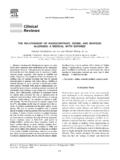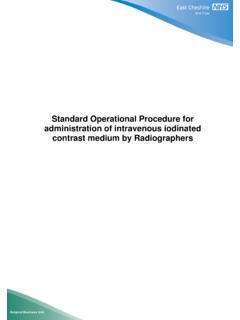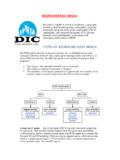Transcription of GASTROGRAFIN (Gas tro graf in) - Medsafe Home …
1 GASTROGRAFIN CMI 1 GASTROGRAFIN ( gas tro graf in ) meglumine diatrizoate & sodium diatrizoate Consumer Medicine Information WHAT IS IN THIS LEAFLET This leaflet answers some common questions about GASTROGRAFIN . It does not contain all the available information. It does not take the place of talking to your doctor or radiologist. All medicines have risks and benefits. Your doctor has weighed the risks of using this medicine against the benefits they expect it will have for you. If you have any concerns about using this diagnostic agent, ask your doctor. Keep this leaflet. You may need to read it again. WHAT GASTROGRAFIN IS USED FOR GASTROGRAFIN is an X-ray contrast medium that acts like an X-ray dye when X-rays of the gastrointestinal tract are being taken. It is provided as a solution for drinking or diluted for use as an enema. GASTROGRAFIN has a sweet taste. All X-ray contrast mediums, including GASTROGRAFIN , contain iodine.
2 Just as X-rays are unable to pass through bones in your body and thus produce a picture , X-rays are unable to pass through the iodine in contrast medium. In this way, GASTROGRAFIN enables the radiologist to see the gastrointestinal tract more clearly. GASTROGRAFIN is often used when a barium enema or meal cannot be used. It is sometimes added to barium to improve the X-ray picture. GASTROGRAFIN is sometimes used to treat meconium ileus, a specific type of bowel blockage. GASTROGRAFIN may also be used for CT scan (Computerised Tomography) in the abdominal region. GASTROGRAFIN is only available in X-ray departments and X-ray practices for use in conjunction with taking X-rays. Ask your doctor if you have any questions about why this medicine has been prescribed for you. BEFORE YOU ARE GIVEN GASTROGRAFIN When you must not use it You must not use or take GASTROGRAFIN if you have an allergy to: meglumine diatrizoate and/or sodium diatrizoate the active ingredients in GASTROGRAFIN iodine any of the ingredients listed at the end of this leaflet.
3 Some of the symptoms of an allergic reaction may include: shortness of breath wheezing or difficulty breathing swelling of the face, lips, tongue or other parts of the body rash, itching or hives on the skin You must not use or take GASTROGRAFIN if: you have an overactive thyroid gland that is being inadequately treated. GASTROGRAFIN must not be used: undiluted in newborns, infants, children or dehydrated patients in patients where there may be a possibility of inhalation of contrast media. If you are not sure whether you should be given GASTROGRAFIN , talk to your doctor. Before you are given it Tell your doctor if you have allergies to any other medicines, foods, preservatives or dyes. GASTROGRAFIN CMI 2 Tell your doctor if you: are pregnant or intend to become pregnant are breastfeeding or intend to breastfeed. You should discuss with your doctor when to discontinue and resume breastfeeding suffer from an allergy ( seafood allergy, hay fever, hives) or bronchial asthma suffer from an allergy to iodine containing contrast media or any other ingredient listed in the section Identification have severe heart disease have known or suspected hyperthyroidism (an overactive thyroid gland).
4 You may require thyroid function testing before administration of GASTROGRAFIN have swelling of the neck caused by enlargement of the thyroid gland (bland nodular goiter) take beta blockers, medicines used to treat high blood pressure or other heart conditions take interleukin suffer from very poor general condition. If you suffer from any of these, your doctor will decide whether the intended examination is possible or not. If you have not told your doctor about any of the above, tell him/her before you are given GASTROGRAFIN . HOW GASTROGRAFIN IS USED Follow all directions given to you by your doctor carefully. They may differ from the information contained in this leaflet. If you do not understand the instructions given, ask your doctor for help. How much is taken/used The actual dose of GASTROGRAFIN that is right for you will be worked out by the doctor and will depend on your age and the type of X-ray examination that is being done.
5 How it is taken/used You will receive GASTROGRAFIN for drinking or diluted as an enema. A cleansing of the bowels before the use of GASTROGRAFIN is recommended. Your doctor will advise you on this. Adequate water and electrolyte (salt) intake should be maintained as GASTROGRAFIN may cause dehydration and electrolyte imbalance. GASTROGRAFIN must not be given as an injection. If you take too much (overdose) As GASTROGRAFIN is administered in specialist centres, overdosage is unlikely. If it does happen the doctor will treat any symptoms that follow. This may involve water and salt replacement through an intravenous drip. The rare and severe side effects noted above can occur regardless of the dosage that is administered. If in doubt it is advisable to telephone the Poisons Information Centre (Australia: 13 11 26 or New Zealand: 0800 POISON or 0800 764 766) for advice if you think that you or anyone else may have taken too much GASTROGRAFIN .
6 Do this even if there are no signs of discomfort or poisoning. You may need urgent medical attention. SIDE EFFECTS Tell your doctor or radiologist as soon as possible if you do not feel well while you are taking GASTROGRAFIN . All medicines can have side effects. Sometimes they are serious, most of the time they are not. You may need medical attention if you get some of the side effects. Do not be alarmed by the following list of side effects. You may not experience any of them. Ask your doctor or radiologist to answer any questions you may have. Tell your doctor or radiologist if you notice any of the following and they worry you. This list includes the more common side effects of your medicine: diarrhoea nausea and vomiting existing inflammation of the bowel may temporarily worsen. GASTROGRAFIN CMI 3 in case of bowel obstruction, prolonged contact of GASTROGRAFIN with the bowel can lead to bleeding due to damage of bowel tissue.
7 The list below includes the rare side effects of your medicine. inhalation of contrast medium into the lungs and subsequent build up of fluid in the lungs skin redness itchy rashes Allergic and allergy like reactions have been observed after use of X ray contrast media such as GASTROGRAFIN . Tell your doctor or radiologist if you notice any of the following and they worry you: nausea vomiting mild swelling of the facelips, tongue or throat conjunctivitis coughing itching running nose sneezing and hives Tell the doctor immediately if you experience any of these reactions as it may be the first sign of developing a severe reaction. Allergy-like reactions have been reported rarely or very rarely after use of X ray contrast media such as GASTROGRAFIN . The symptoms are usually mild and generally occur in the form of skin reactions. The risk of allergic reactions is higher if you have a history of allergic disorders, have bronchial asthma, have previously had an allergic reaction to iodinated contrast media, or have a heart condition.
8 Other reactions include: chest pain and pneumonia sneezing a sore ulcerated mouth delayed reactions ( fever, rash, flu-like symptoms, joint pain or itchiness) can occasionally occur and are more likely in patients who have received interleukin. If you are unsure about the effect of this product, please discuss this with your doctor. Tell your doctor or radiologist if you notice anything that is making you feel unwell. Other side effects not listed above may also occur in some people. AFTER USING GASTROGRAFIN Storage The X-ray department or X-ray practice will store GASTROGRAFIN under conditions advised by the manufacturer. Shelf life and storage conditions are printed on the bottle. Disposal Unused GASTROGRAFIN must be discarded within 72 hours after opening the bottle. PRODUCT DESCRIPTION What it looks like GASTROGRAFIN is supplied in bottles of 100 mL and 250 mL. Not all pack sizes may be marketed. Ingredients Active ingredients: GASTROGRAFIN contains 100 mg sodium amidotrizoate and 660 mg meglumine amidotrizoate per mL Inactive ingredients: disodium edetate saccharin sodium polysorbate 80 anise oil purified water.
9 Supplier Made in Spain for: Bayer Australia Limited ABN 22 000 138 714 875 Pacific Highway Pymble NSW 2073 Bayer New Zealand Limited 3 Argus Place, Hillcrest, North Shore Auckland 0627 Australian registration number GASTROGRAFIN - AUST R 10684 Date of preparation September 2011 See TGA website ( ) for latest Australian Consumer Medicine Information. See Medsafe website ( ) for latest New Zealand Consumer Medicine Information. Registered Trademark of Bayer AG, Germany GASTROGRAFIN CMI 4 Bayer Australia Ltd All rights reserved.















